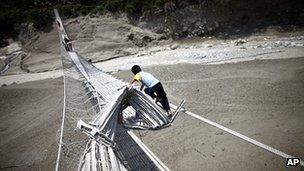Dozens missing in Nepal floods near Annapurna
- Published
A search operation was launched to find dozens of people who were swept away with their livestock.
Dozens of people are still missing in Nepal after a mountain river burst its banks near Mount Annapurna, in the west of the country, causing flash flooding, police say.
A police official told AFP that a search operation for the 43 missing people was under way, but he saw little chance of finding any of them alive.
Three Ukrainian tourists trekking in the area are among the missing.
At least 13 people died when the floods surged down the Seti river on Saturday.

The floods damaged a suspension bridge used by the residents of Kharapani village
Eight people have been rescued from the surge of water. The area is popular with tourists.
"We have a list of another 43 people who have gone missing. Their chances of survival are almost zero. The three Ukrainians are still missing," district police superintendent Sailesh Thapa told AFP.
Earlier reports said the three missing foreigners were Russians.
Mr Thapa said earth-moving equipment had reached the worst-affected area in an effort to find any bodies buried in the mud.
Fast-flowing floodwaters from the swollen Seti smashed into two buildings and a number of shacks in the village of Kharapani, in Kaski district.
One eyewitness, Uddha Bahadur Gurung, described the moment the surge hit:
"There was nothing unusual. People were enjoying picnics, some were relaxing in the hot spring pools by the river and others working," he told the Kathmandu Post.
"Out of nowhere came this swelling dark murky water with debris, sweeping away many people."

One local woman said she was collecting fire when the flood hit. "We haven't seen such a flash flood in years," she said.
"I saw floods 60 years ago but it was not as severe as now. This time they say everything across the river has been swept away."
The floodwaters also swept into the city of Pokhara, where several people were swept away along with their houses and livestock.
May is the end of the trekking season, but before the monsoon.
The floods are thought to have been caused by waters of the Seti building near its source, high above the snowline, during days of rain and then suddenly bursting free, army spokesman Ramindra Chhetri told AFP.
- Published5 January 2011